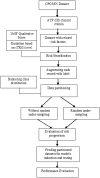A Systematic Machine Learning Based Approach for the Diagnosis of Non-Alcoholic Fatty Liver Disease Risk and Progression
- PMID: 29391513
- PMCID: PMC5794753
- DOI: 10.1038/s41598-018-20166-x
A Systematic Machine Learning Based Approach for the Diagnosis of Non-Alcoholic Fatty Liver Disease Risk and Progression
Abstract
Prevention and diagnosis of NAFLD is an ongoing area of interest in the healthcare community. Screening is complicated by the fact that the accuracy of noninvasive testing lacks specificity and sensitivity to make and stage the diagnosis. Currently no non-invasive ATP III criteria based prediction method is available to diagnose NAFLD risk. Firstly, the objective of this research is to develop machine learning based method in order to identify individuals at an increased risk of developing NAFLD using risk factors of ATP III clinical criteria updated in 2005 for Metabolic Syndrome (MetS). Secondly, to validate the relative ability of quantitative score defined by Italian Association for the Study of the Liver (IASF) and guideline explicitly defined for the Canadian population based on triglyceride thresholds to predict NAFLD risk. We proposed a Decision Tree based method to evaluate the risk of developing NAFLD and its progression in the Canadian population, using Electronic Medical Records (EMRs) by exploring novel risk factors for NAFLD. Our results show proposed method could potentially help physicians make more informed choices about their management of patients with NAFLD. Employing the proposed application in ordinary medical checkup is expected to lessen healthcare expenditures compared with administering additional complicated test.
Conflict of interest statement
The authors declare that they have no competing interests.
Figures
References
-
- Kashanian, S. & Fuchs, M. Non-Alcoholic Fatty Liver Disease in Patients with Diabetes Mellitus: A Clinicianâ s Perspective. Int. J.l of Dig. Dis. (2015).
Publication types
MeSH terms
LinkOut - more resources
Full Text Sources
Other Literature Sources
Medical



